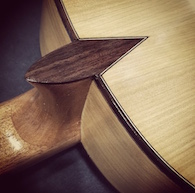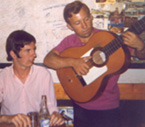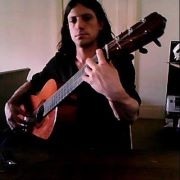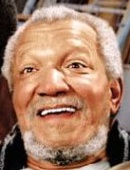Welcome to one of the most active flamenco sites on the Internet. Guests can read most posts but if you want to participate click here to register.
This site is dedicated to the memory of Paco de Lucía, Ron Mitchell, Guy Williams, Linda Elvira, Philip John Lee, Craig Eros, Ben Woods, David Serva and Tom Blackshear who went ahead of us.
We receive 12,200 visitors a month from 200 countries and 1.7 million page impressions a year. To advertise on this site please contact us.
|

|
|
Old Flamenco
|
You are logged in as Guest
|
|
Users viewing this topic: none
|
|
Login  | |
|

   
Phil
Posts: 382
Joined: Jul. 7 2003
From: Rota, Spain

|
 Old Flamenco Old Flamenco
|
|
|
Recently I've been listening to some very old Flamenco recorded prior to 1933 at the CAF web site. If anyone thinks that these old guitarists only played simplistic stuff, you are in for a surprise. I've been listening to Manuel Torre accompanied mostly by Juan Gandulla 'Habichuela,' Miguel Borrull, hijo or Javier Molina. The playing is impressive. You'd be surprised by the amount of picado used, especially by Miguel Borrull, hijo. It's becomes obvious that Sabicas didn't invent picado.
To find the Manuel Torre recordings, go to http://caf.cica.es/mundo_flamenco/ on the left click on Rincon del Cante. You'll see 10 volumes of 'Figuras del Cante,' go the the bottom of the page and click on 'aqui'. You'll see Manuel Torre, Antonio Chacon, etc.
The quality of most of the Manuel Torre recordings are fairly decent, but some of the others are so bad that they're really of interest only to flamencologists. But check it out, I think you be in for a real eye-opener.
Phil
|
|
|
|
REPORT THIS POST AS INAPPROPRIATE |
Date Jan. 11 2004 0:15:54
 |
|

   
Thomas Whiteley
Posts: 786
Joined: Jul. 8 2003
From: San Francisco Bay Area

|
 RE: Old Flamenco (in reply to Phil) RE: Old Flamenco (in reply to Phil)
|
|
|
Tom stated:
“Originally, the guitar was held in the lap with the neck pointed up, and strummed.
Several people contributed to the advancement of guitar technique and Ramon Montoya is among them. Montoya introduced techniques from classical guitar developed by Francisco Tárrega, such as arpeggio, tremolo and picado. Picado apparently began with the pulgar or thumb. Sabicas appears to be the first to use indice, medio for picado”.
_____________________________________________________________________
Phil responded:
“Tom said,
quote:
Sabicas appears to be the first to use indice, medio for picado”.
“Are you sure of this? Didn't Ramon Montoya use picado? I used to have an album of his and I'm sure he used picado. I've just listened to a Buleria por Solea recorded sometime prior to 1933 and the guitarist, Miguel Borrull, hijo, is clearly using picado. These guys were around long before Sabicas and it seems they were using picado”.
____________________________________________________________________
Phil;
The recordings of flamenco guitarists exist from many years ago. There are even a few from the period of around 1890 and one earlier on a wax cylinder. I have a number of films of flamenco guitarists dating from 1930. Also, I have read a number of accounts of flamenco guitar technique attributed to many fine players.
I believe I stated (as best as I am able to interpret my own words) that Ramon Montoya introduced a number of classical guitar techniques and picado was one of them. My statement about Sabicas was that he appears to be the first flamenco guitarist to have used indice, Medio picado rather than pulgar.
I have a couple of films with Sabicas and other guitarists playing picado. Some of the film is with Carmen Amaya. The other players played pulgar picado and could they play! I am amazed at the speed these men had with only the pulgar.
A pulgar technique used years ago and rarely seen today was to use a pulgar rest stroke and quickly bring the pulgar up. This gave a fast powerful sound and is similar to the use of a pick. Variations of this technique were used and this was unlike Alzapua as there was no down stroke rasgueado following the pulgar down. I have some Diego del Gastor recordings (audio and video) of this technique being used and some tabs from Evan Harrar in which Evan instructed me on this technique in some detail.
When I say "it appears", that is what I meant. It is possible that others used it to some extent but I have no evidence. One thing about the technique used by Sabicas, he had little contact with other flamenco guitarists as he came from Northern Spain (Pamplona) and did things his own way.
I hope I have made clearer my statement on this subject. There were many fine flamenco guitarists during the early 20th century and each one had an individual sound. I think today too many flamenco guitarists are interested in sounding like “the person who is most famous this week”!

_____________________________
Tom
http://home.comcast.net/~flamencoguitar/flamenco.html
|
|
|
|
REPORT THIS POST AS INAPPROPRIATE |
Date Jan. 11 2004 22:06:49
 |
|

   
Phil
Posts: 382
Joined: Jul. 7 2003
From: Rota, Spain

|
 RE: Old Flamenco (in reply to Phil) RE: Old Flamenco (in reply to Phil)
|
|
|
Tom said,quote:
When I say "it appears", that is what I meant. It is possible that others used it to some extent but I have no evidence.
I obviously can't see how the guitarists on these old recording are playing, which is why I also used words like 'seems' and 'appears'. I can only go by my ear (a notoriously untrustworthy ear, I might add), but it does sound to me like Miquel Borrull, hijo, is using standard picado simple because it is so fast. By no means am I claiming to be able to tell the difference solely by the sound. (There are a few people over at F-T that probably could, though.  ) )
I know (via Chuck Keyser's books) that Diego del Gastor used lot of thumb upstrokes on single strings where other guitarists would use rapid downstrokes. I think the technique is still referred to as 'alzapua' even if only one string is involved. 'Alzar' = 'to raise' and 'pua' = 'plectrum', so as I understand it, any continuous up and down action of the thumb is called 'alzapua', whether you cover multiple strings or only one. I could be wrong and I'd like to hear what others have to say regarding their understanding of 'alzapua'.
I still have a gut feeling (from listening to these old recordings) that the i,m, picado pre-dates Sabicas. I may take this question to the 'Bad Boys List'. There are of few rational people like Brook Zern and John Moore that still post there. Not that I'm doubting you, Tom, but as Ronald Reagan used to say about the Russians, 'Trust, but verify.' 
To change the subject -- there's a 1909 recording of Chacon accompanied by Juan Gandulla 'Habichuela' on the CAF web site. In order to clean up the sound the first thing they did was to play the disk backwards and re-record it. They did this in order to reproduce the sound from the opposite side of the groove, which was not as worn down as the side that the needle normally rides against. I thought that you might find that interesting since you have an interest in recording, I know that I did. I wonder if they heard any satanic messages?
Phil
|
|
|
|
REPORT THIS POST AS INAPPROPRIATE |
Date Jan. 11 2004 23:44:40
 |
|

   
Richard Jernigan
Posts: 3430
Joined: Jan. 20 2004
From: Austin, Texas USA

|
 RE: Old Flamenco (in reply to Ricardo) RE: Old Flamenco (in reply to Ricardo)
|
|
|
I agree that picado hardly started with Sabicas. Ramon Montoya was well acquainted with the classical guitarist Miguel Llobet. Montoya clearly used techniques influenced by classical playing. Javier Molina pre-dated Montoya by quite a bit. He played picado, arpegio and tremolo. Much earlier than Molina recordings are scarce to nonexistent, but oral tradition speaks of cross fertilization going back to Julian Arcas's and Tarrega's influence on Paco de Lucena and Patiño.
I disagree that most of Sabicas's stuff was note for note copies of Ramon Montoya. He was clearly strongly influenced by Montoya, and it seems reasonable that some of his stuff started off as pieces copped off Montoya recordings. But Sabicas's playing was constantly evolving. If you heard him in person at concerts and juergas, you never heard the same palo played the same way twice. He wasn't just mixing up his vast repertoire of falsetas, the falsetas themselves were constantly changing.
In New York in the early 1960s I asked one of Sabicas's young disciples how much he practiced. He replied, "He never practices."
"How does he keep up that technique then?"
"He plays all the time. If he's not in bed, eating, or playing poker, he has a guitar in his hands. He plays all day, and it's never the same from one day to the next."
RNJ
|
|
|
|
REPORT THIS POST AS INAPPROPRIATE |
Date Feb. 1 2012 20:56:05
 |
|
 New Messages New Messages |
 No New Messages No New Messages |
 Hot Topic w/ New Messages Hot Topic w/ New Messages |
 Hot Topic w/o New Messages Hot Topic w/o New Messages |
 Locked w/ New Messages Locked w/ New Messages |
 Locked w/o New Messages Locked w/o New Messages |
|
 Post New Thread
Post New Thread
 Reply to Message
Reply to Message
 Post New Poll
Post New Poll
 Submit Vote
Submit Vote
 Delete My Own Post
Delete My Own Post
 Delete My Own Thread
Delete My Own Thread
 Rate Posts
Rate Posts
|
|
|
Forum Software powered by ASP Playground Advanced Edition 2.0.5
Copyright © 2000 - 2003 ASPPlayground.NET |
0.078125 secs.
|


 Printable Version
Printable Version







 )
) 




 New Messages
New Messages No New Messages
No New Messages Hot Topic w/ New Messages
Hot Topic w/ New Messages Hot Topic w/o New Messages
Hot Topic w/o New Messages Locked w/ New Messages
Locked w/ New Messages Locked w/o New Messages
Locked w/o New Messages Post New Thread
Post New Thread